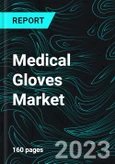Medical gloves market forecast at $19.3 billion by 2027
Dublin, Ireland – Medical Gloves Market will reach US$ 19.30 Billion by the end of year 2027 according to Research and Markets. Medical gloves are disposable and reusable gloves used during medical surgeries and examinations and preferably help to prevent the spread of illness or infections.
Medical Gloves are made from various raw materials, including latex, nitrile rubber, vinyl rubber, neoprene, and others. These raw materials are available in the powdered or non-powdered form, and healthcare professionals use gloves during surgical examinations, the commission of a crime, and others.
The demand for medical gloves has increased due to the continuously rising number of surgeries, major chronic diseases, improved healthcare systems, and the essential nature of surgical gloves are some of the primary growth drivers for the market. According to our research report, Worldwide Medical Gloves Market is expected to grow with a double digit CAGR of 7.65% from 2022 to 2027.
The rising contagious diseases are increasing the demand for medical gloves worldwide. Furthermore, the healthcare industry in major developing countries is expected to witness prime growth owing to several factors, including growing investments in public and private sectors, a rising geriatric population, an increasing population, and a high influx of migrants.
However, hazardous responses induced by gloves and high price rivalry from local manufacturers are expected to boost the medical gloves market’s expansion. For example, accelerators and other chemicals used in producing latex and non-latex gloves can induce allergic responses such as irritating contact dermatitis. Conversely, introducing disposable gloves into undeveloped nations creates significant business potential.
Based on raw material, the Nitrile gloves dominate the market share during the forecast period due to rising use by healthcare professionals. The raw material market was segmented into latex gloves, Nitrile gloves, vinyl gloves, and Neoprene gloves. In addition, Nitrile gloves offer benefits such as long shelf life, less friction, and puncture resistance than latex gloves. Furthermore, rising awareness regarding latex allergies is anticipated to drive the demand for these products during the projection period.
Based on Sterility, the Global Medical Glove market was categorized into two types’ sterile gloves and Non Sterile gloves. Non- Sterile gloves will grow more during the forecast period due to rapid use in hospitals and clinics and have minimal risk of infections, and can be used multiple times as compared to sterile gloves.
Based on form, Non-Powdered holds the most significant market revenue due to an increasing preference for powder-free gloves for several surgical and non-surgical procedures. These gloves do not contain starch powder as they are associated with several allergies and side effects when used for a prolonged duration and may result in a hazardous medical situation.
Based on application type, the Global Medical Glove Market was categorized into two types: examination and surgical gloves, surgical gloves hold the larger market share. The surgical Gloves market is growing owing to rising awareness of hygiene among healthcare professionals and a growing number of hospital admissions. Surgical gloves worn by surgeons and healthcare professionals were specially designed and made direct contact with harmful objects.
Rising Rates of Infectious Diseases and the Establishment of Infection Prevention Standards are Propelling the Hospital Market
End Users classified the market into Hospitals, Clinics, Ambulatory Surgery, Diagnostic centres, and others. The hospital holds the maximum market share during the forecast period due to increasing patient admissions in clinics, examination procedures, and demand for advanced technology advancements in the hospital sector. The rapidly growing geriatric population, especially in developed countries, coupled with the rising prevalence of hospital-acquired and other infections, such as hepatitis and AIDS, is likely to augment the demand for these products.
The increasing prevalence of Hospital Acquired Infections (HAIs), such as surgical site infection, ventilator-associated pneumonia, and bloodstream infection, is likely to drive product demand in the hospital end-use segment. Furthermore, the growing geriatric population, combined with a rise in chronic health concerns, is predicted to drive industry growth.

